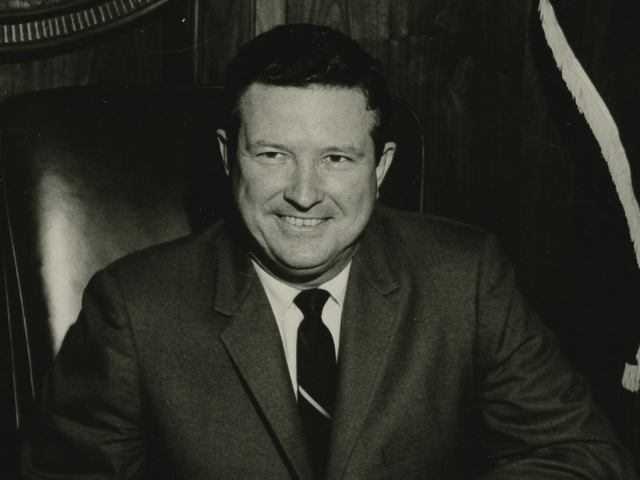
An undated portrait of Gov. Robert McNair smiling. From the South Carolina Political Collections at the University of South Carolina.
(1923-2007) McNair was born in Williamsburg County, the only child of Daniel Evander McNair and Claudia Crawford. He graduated from Macedonia High School. During World War II, McNair enlisted in the U.S. Navy and served twenty-two months in the Pacific theater. McNair married Josephine Robinson of Allendale in San Francisco on May 30, 1944, only days prior to his being shipped overseas. The marriage produced four children.
After military service, McNair returned to the University of South Carolina, where he earned the A.B. degree and the LL.B. He entered law practice in Moncks Corner and ran for political office for the first time, losing in a race for the House of Representatives. It would be the only loss of his political career. The McNairs moved to Allendale, where he set up law practice and ran again for public office. He won the state House seat from Allendale County in 1951 and launched a successful political career. He became chairman of the House Committee on Labor, Commerce, and Industry in his second term and shepherded through the state’s right-to-work law that limited the power of labor unions and strengthened the state’s industrial recruitment efforts. Two years later, McNair became chairman of the powerful House Judiciary Committee, a position he held until he ran. and won, the office for lieutenant governor in 1962.
McNair became governor in 1965, upon the resignation of incumbent governor Donald S. Russell. McNair was elected to a full term on November 8, 1966, with significant support from newly enfranchised black voters. The McNair administration coincided with major civil rights initiatives and significant public protests and demonstrations in the last half of the 1960s. A classroom boycott at South Carolina State College resulted in the replacement of the college’s president, changing of student roles and procedures, and significant new funding for the institution. The following year protests at a segregated bowling alley in Orangeburg resulted in the killing of three demonstrators and the wounding of thirty-two others on the S.C. State campus. At the Medical College Hospital in Charleston, a 113-day strike protested wages and working conditions among low-income black workers and sought to gain state recognition for their union local. The governor also faced two weeks of protests against the Vietnam War at the University of South Carolina by students seeking to close the institution in the wake of the shooting deaths of four students at Kent State University in Ohio.
Except for the tragedy at Orangeburg in February 1968, McNair saw the state peacefully through the stormy times without yielding on major policy issues. Settlement of the Charleston strike without union recognition in 1969 and keeping USC open in 1970 without serious injury to students were foremost among many public demonstrations in the state in which his moderate leadership was credited with minimizing violence. McNair also guided the state peacefully through the first year of total desegregation of the public school system in 1970. McNair made the first appointments of black citizens to state boards and commissions and desegregated his own executive staff in the Governor’s Office.
McNair championed compulsory school attendance and was successful in initiating public kindergartens. McNair pursued the recruitment of new industries and jobs, and he began the program of soliciting overseas investments, a strategy that blossomed under subsequent governors. It was also at his recommendation that the Department of Parks, Recreation, and Tourism was created in 1967, triggering the state’s long and successful development of tourism as a multibillion-dollar industry.
After leaving office in January 1971, McNair established the McNair Law Firm in Columbia, which grew to become one of the major firms in the South. He did not seek or serve in public office again after 1971.


